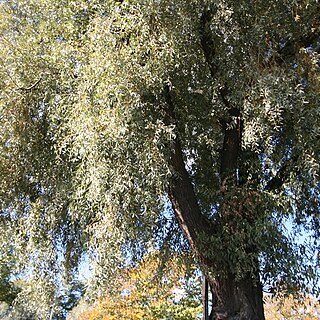Plants sometimes forming clones by stem fragmentation. Stems: branches (highly brittle at base), gray-brown or violet, not glaucous, tomentose to glabrescent; branchlets red-brown, violet, or mottled yellow-brown, sparsely to densely velvety. Leaves: stipules absent or rudimentary on early ones, late ones 1.2-4 mm, apex acute or acuminate; petiole convex to flat, or shallowly grooved adaxially, 3.5-12(-21) mm, (sometimes 2 spherical glands distally), velvety adaxially; largest medial blade lorate, narrowly oblong, or narrowly elliptic, (48-)54-82-100(-125) × (7-)9-16.7-25 mm, base cuneate or convex, margins flat, serrulate or crenulate, apex acute, acuminate, or convex, abaxial surface glaucous (sometimes obscured by hairs), densely short-silky, hairs straight, adaxial dull, sparsely pubescent to glabrescent; proximal blade margins entire; juvenile blade reddish or yellowish green, very densely short-silky abaxially, hairs white, sometimes also ferruginous. Catkins flowering as or just before leaves emerge; staminate stout, 13.5-40 × 4-9 mm, flowering branchlet 0-2 mm; pistillate loosely to moderately densely flowered, slender to stout, 18-43 × 5-12 mm, flowering branchlet 1-3 mm; floral bract dark brown, black, or bicolor, 0.8-1.5 mm, apex rounded, abaxially hairy, hairs straight or wavy. Staminate flowers: adaxial nectary ovate to oblong, 0.3-0.8 mm; filaments distinct or connate less than 1/2 their lengths; anthers purple turning yellow, 0.4-0.6 mm. Pistillate flowers: adaxial nectary oblong, ovate, or flask-shaped, 0.4-0.7 mm; ovary ovoid, beak abruptly tapering to styles; ovules 6 per ovary; styles 0.2-0.4 mm. Capsules 2.5-4 mm.
More
Shrub or small tree, to 4 m; twigs brittle at the base, slender, brown, densely gray-to brown-tomentose when young, later glabrate except often at the nodes; stipules lanceolate to semi-ovate, 3–10 mm, often deciduous; petioles slender, 5–10 mm, puberulent; lvs narrowly lanceolate to lanceolate, 6–10(–14) × 1–2.5(–3) cm, acuminate, cuneate at base, closely glandular-serrate, dark green and puberulent to glabrous above, glaucous and densely to thinly short-sericeous beneath; catkins ± precocious, 1–4 cm, subsessile or on narrow-bracted peduncles to 1 cm; scales 1 mm, blackish, villous; stamens 2; frs ovoid-oblong, 3–5 mm, blunt, short-sericeous; pedicels 0.5–1(–1.5) mm; style 0.1–0.3 mm. Moist, rocky ground, often in or near running water; N.S. and N.B. to Wis. and e. Io., s. to S.C., n. Ga. and n. Ark. (S. coactilis) A possible hybrid with no. 29 [Salix viminalis L.] is S. ×subsericea (Andersson) C. K. Schneid.
Wet, boggy shores, sandy terraces, ledges along streams, low woods, sedge meadows, acid bogs, open seepages, rocky, silty, sandy, or peaty substrates, possibly also on serpentine soils; at elevations up to 1,300 metres


